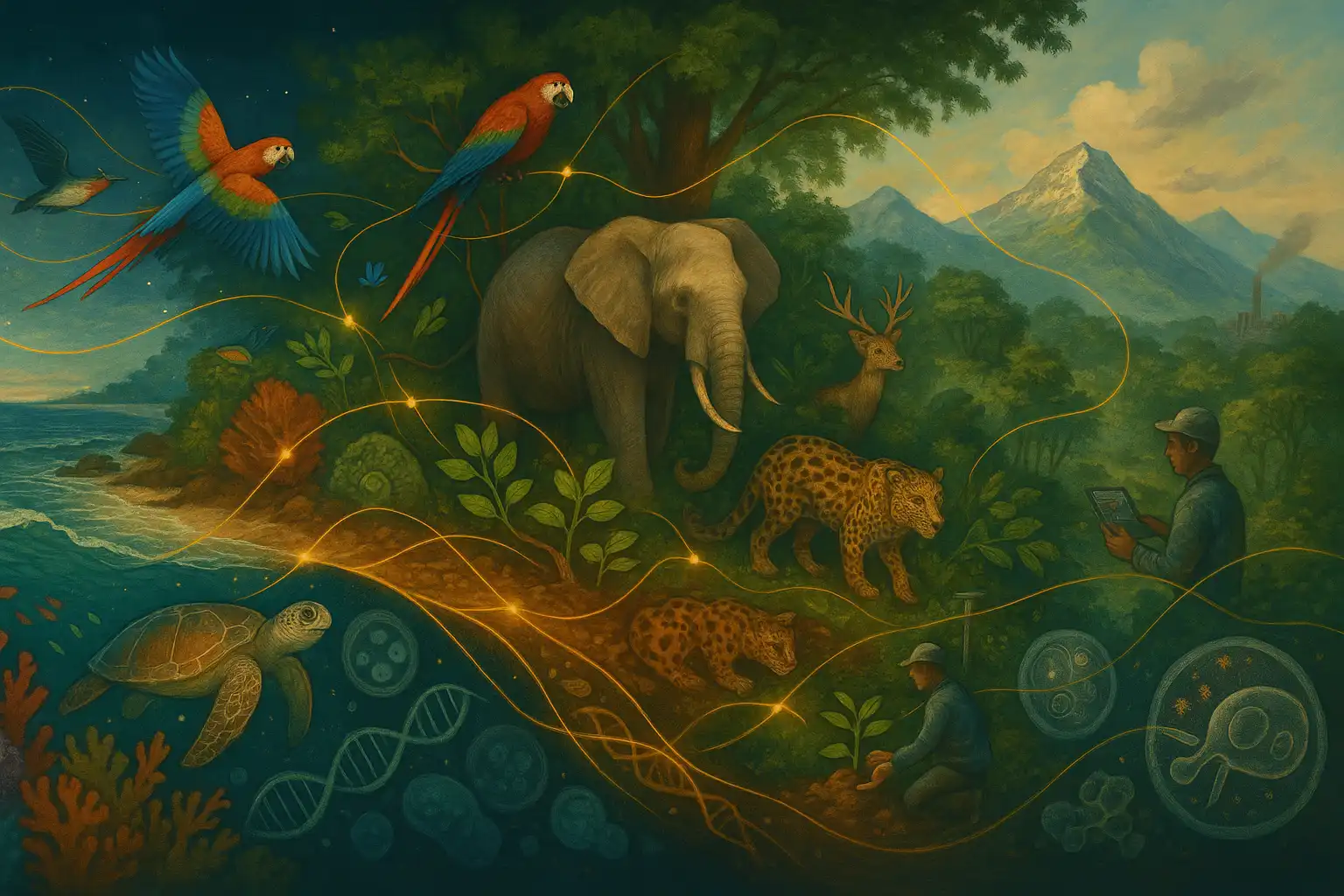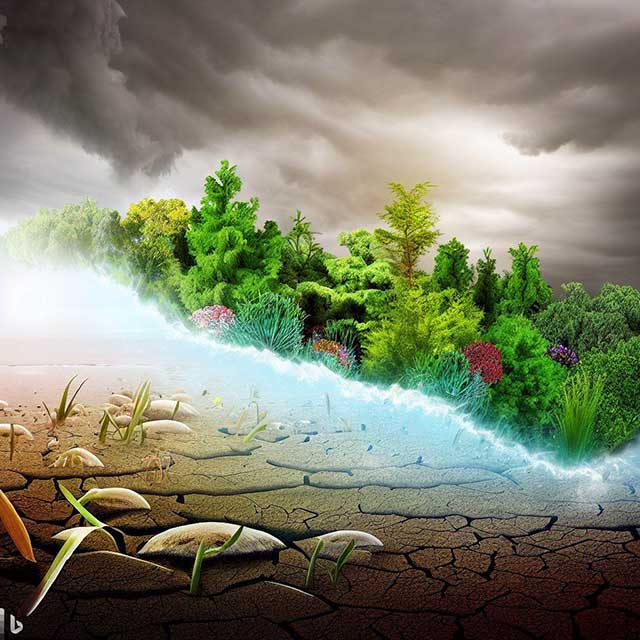Contents
1. Introduction: The Global Climate Emergency and Biodiversity Crisis
2. The Global Climate Emergency: A Call to Listen to Science
3. Crucial Climate Change Numbers: Understanding the Paris Agreement Goals
4. Biodiversity Loss and Ecosystem Degradation: A Threat to Society, Economy, and Human Health
5. Addressing Climate Change and Biodiversity Loss Together: A Crucial Connection
6. The European Green Deal: A Transformative Policy Framework for a Climate-Neutral and Resilient Europe
7. Nature-Based Solutions and Green Infrastructure: Working with Nature to Fight Climate Change and Preserve Biodiversity
8. Our Responsibility as Guardians of the Earth: Ensuring a Sustainable Future for Generations to Come
Introduction: Understanding the Global Climate Emergency and Biodiversity Crisis
Our planet is currently facing two major challenges: climate change and biodiversity loss and ecosystem degradation. The global scientific community has been sounding the alarm on the climate emergency, urging us to take immediate action to mitigate the devastating consequences of our actions on the environment. In this comprehensive guide, we will delve deeper into the urgent need for climate action and biodiversity preservation, exploring the crucial connection between these two challenges and the transformative policies and solutions required to ensure a sustainable future for generations to come.
The Climate Emergency: Causes, Impacts, and Solutions
Causes of Climate Change
Climate change is primarily caused by the increased emission of greenhouse gases (GHGs) such as carbon dioxide, methane, and nitrous oxide. These emissions are mainly due to human activities, including the burning of fossil fuels, deforestation, and industrial processes. As a result, the Earth's average temperature has risen, leading to a range of negative impacts on the environment and human societies.
Impacts of Climate Change
The consequences of climate change are far-reaching and include more frequent and severe weather events, rising sea levels, and disruptions to ecosystems and agriculture. These impacts pose significant risks to human health, food security, and economic stability, disproportionately affecting vulnerable populations and exacerbating existing inequalities.
Climate Change Solutions
To address the climate emergency, we must implement a combination of mitigation and adaptation strategies. Mitigation efforts focus on reducing GHG emissions by transitioning to renewable energy sources, improving energy efficiency, and promoting sustainable land use practices. Adaptation strategies involve preparing for and responding to the impacts of climate change, such as investing in resilient infrastructure and developing early warning systems for extreme weather events.
The Biodiversity Crisis: Causes, Impacts, and Solutions
Causes of Biodiversity Loss and Ecosystem Degradation
Biodiversity loss and ecosystem degradation are driven by a variety of human activities, including habitat destruction, overexploitation of natural resources, pollution, and the introduction of invasive species. Climate change further exacerbates these threats, as rising temperatures and changing precipitation patterns disrupt ecosystems and force species to adapt or face extinction.
Impacts of Biodiversity Loss and Ecosystem Degradation
The loss of biodiversity and degradation of ecosystems have profound implications for human well-being, as they undermine the essential services that nature provides, such as clean air and water, food production, and climate regulation. Additionally, the loss of species and genetic diversity reduces the resilience of ecosystems, making them more vulnerable to disturbances and less able to recover from shocks.
Biodiversity Preservation Solutions
To address the biodiversity crisis, we must prioritize habitat conservation and restoration, sustainable resource management, and the integration of biodiversity considerations into all aspects of policymaking and planning. This includes establishing and effectively managing protected areas, promoting sustainable agriculture and forestry practices, and investing in research and monitoring to better understand and respond to the drivers of biodiversity loss.
The Interconnectedness of Climate Action and Biodiversity PreservationThe
The challenges of climate change and biodiversity loss are deeply interconnected, as the health of ecosystems plays a critical role in regulating the Earth's climate. For example, forests act as carbon sinks, absorbing and storing large amounts of carbon dioxide, while healthy oceans help regulate temperature and weather patterns. Therefore, efforts to address one challenge must also consider the other, and integrated solutions that promote both climate action and biodiversity preservation are essential for a sustainable future.
Transformative Policies and Solutions for a Sustainable Future
To effectively tackle the global climate emergency and biodiversity crisis, we need transformative policies and solutions that address the root causes of these challenges and promote a just transition to a sustainable, low-carbon, and biodiverse future. This includes:
- Strengthening international cooperation and commitments, such as the Paris Agreement and the Convention on Biological Diversity.
- Implementing comprehensive climate and biodiversity policies at the national and local levels, including carbon pricing, renewable energy incentives, and habitat conservation measures.
- Encouraging businesses to adopt sustainable practices and invest in clean technologies, through regulations, incentives, and consumer pressure.
- Empowering individuals and communities to take action, by raising awareness, promoting sustainable lifestyles, and supporting local conservation initiatives.
By working together to address the climate emergency and biodiversity crisis, we can safeguard our planet's life-support systems and ensure a sustainable future for generations to come.
The Global Climate Emergency: A Call to Listen to Science
Understanding the Climate Crisis: Rising Temperatures and Their Effects
Over the past decade, global surface temperatures have risen by about one degree Celsius compared to pre-industrial levels. This increase in temperature is primarily due to human activities, such as the burning of fossil fuels and deforestation, which release large amounts of greenhouse gases into the atmosphere. European land temperatures have increased even faster, by almost two degrees Celsius, causing significant changes to the region's climate and ecosystems.
The Impact of Rising CO2 Emissions on Climate Change
Global fossil fuel CO2 emissions, a major contributor to climate change, have steadily increased, showing no signs of peaking. This continuous rise in emissions is a cause for concern, as it exacerbates the effects of climate change and makes it more difficult to mitigate its impacts. To address this issue, it is crucial to reduce our reliance on fossil fuels and transition to cleaner, more sustainable energy sources.
Consequences of Climate Change: Heatwaves and Crop Production
As a result of the rising temperatures and increased CO2 emissions, we are experiencing stronger climate change impacts. One such impact is the occurrence of more intense heatwaves, which pose a threat to human health, particularly for vulnerable populations such as the elderly and those with pre-existing health conditions. Additionally, heatwaves can lead to increased energy consumption for cooling, putting a strain on energy infrastructure and contributing to further greenhouse gas emissions.
Another consequence of climate change is the drop in crop production, particularly in southern Europe. Higher temperatures and more frequent droughts can negatively affect crop yields, leading to food shortages and increased food prices. This not only impacts the economy but also threatens food security for millions of people.
The Importance of Science-Based Solutions to Combat Climate Change
In order to effectively address the global climate emergency, it is essential to listen to science and implement evidence-based solutions. This includes investing in renewable energy sources, promoting energy efficiency, and adopting sustainable agricultural practices. By taking these steps, we can work towards reducing greenhouse gas emissions and mitigating the impacts of climate change on our planet and its inhabitants.
Key Takeaways: The Urgency of Addressing the Climate Crisis
In conclusion, the global climate emergency is a pressing issue that requires immediate action. Rising temperatures, increasing CO2 emissions, and the resulting impacts on human health and food production are just a few examples of the challenges we face. By listening to science and implementing effective solutions, we can work towards a more sustainable future and protect our planet for generations to come.
Crucial Climate Change Numbers: Understanding the Paris Agreement Goals and Their Importance

To better comprehend the urgency of climate action and the significance of the Paris Agreement, it is essential to understand some key numbers related to climate change. In this section, we will discuss the current policy commitments, the global temperature increase, and the required reduction in global emissions to achieve the Paris Agreement's objectives.
Current Policy Commitments and Projected Temperature Increase
The Paris Agreement's current policy commitments will likely result in a global temperature increase of 3.2 degrees Celsius this century if no further action is taken. This is a concerning number, as it would lead to more severe and frequent extreme weather events, such as heatwaves, droughts, and storms, which would have devastating consequences for ecosystems, human health, and economies worldwide.
By 2030, global emissions are projected to reach 56 gigatons of CO2 if we continue on the current trajectory. This is far from the ideal scenario, as it would make it extremely challenging to limit global warming and avoid the worst impacts of climate change.
The Paris Agreement's Temperature Goals
The primary objective of the Paris Agreement is to keep the global temperature increase well below 2 degrees Celsius compared to pre-industrial levels. Moreover, the agreement aims to limit the temperature increase even further, to 1.5 degrees Celsius, if possible. Achieving this more ambitious goal would significantly reduce the risks and impacts of climate change, such as sea-level rise, loss of biodiversity, and threats to food security.
Reducing Global Emissions to Achieve the Paris Agreement Goals
To achieve the Paris Agreement's temperature goals, global CO2 emissions must rapidly drop to 25 gigatons by 2030. This requires a 7.6% reduction in global emissions every year from now until 2030. Such a drastic reduction in emissions is necessary to prevent the worst effects of climate change and ensure a sustainable future for all.
Challenges and Solutions for Reducing Emissions
Meeting the Paris Agreement's goals is undoubtedly a challenging task, but it is not impossible. Some potential solutions for reducing emissions include:
- Transitioning to renewable energy sources: By shifting from fossil fuels to renewable energy sources like solar, wind, and hydroelectric power, we can significantly reduce greenhouse gas emissions.
- Improving energy efficiency: Implementing energy-efficient technologies and practices in industries, buildings, and transportation can help reduce energy consumption and emissions.
- Reforestation and afforestation: Planting trees and restoring degraded forests can act as carbon sinks, absorbing CO2 from the atmosphere and helping to mitigate climate change.
- Promoting sustainable agriculture: Adopting sustainable farming practices, such as agroforestry and organic farming, can reduce emissions from agriculture while also improving soil health and biodiversity.
- Encouraging individual actions: Every person can contribute to reducing emissions by adopting sustainable lifestyle choices, such as using public transportation, reducing waste, and conserving energy at home.
By understanding the crucial numbers related to climate change and the Paris Agreement goals, we can better appreciate the urgency of climate action and work together to implement effective solutions for a more sustainable future.
Biodiversity Loss and Ecosystem Degradation: A Threat to Society, Economy, and Human Health
Understanding the Importance of Biodiversity and Ecosystem Health
Europe is currently facing a dramatic degradation of ecosystems and rapid loss of biodiversity, with significant declines in populations of common birds and butterflies. These trends can be strong indicators of the health of ecosystems in Europe. Biodiversity loss and ecosystem degradation can have fundamental consequences on society, the economy, human health, and well-being. It is crucial to understand the importance of biodiversity and ecosystem health to address these issues effectively.
The Impact of Biodiversity Loss on Crop Yields and Food Security
One of the most significant consequences of biodiversity loss is the decline in pollinator populations, such as bees and butterflies. Pollinators play a crucial role in agriculture, as they help fertilize plants and increase crop yields. The loss of pollinators can lead to reduced crop yields, which can have a ripple effect on food security and the economy. According to a study by the Intergovernmental Science-Policy Platform on Biodiversity and Ecosystem Services (IPBES), the global value of crop production directly dependent on pollinators is estimated to be between $235 billion and $577 billion annually.
The Connection Between Habitat Destruction and Zoonotic Diseases
Another critical aspect of biodiversity loss and ecosystem degradation is the destruction of natural habitats, which can increase the risk of zoonotic diseases, such as COVID-19. Zoonotic diseases are illnesses that can be transmitted from animals to humans, and habitat destruction can lead to closer interactions between wildlife and human populations. This increased contact can facilitate the transmission of diseases, posing a significant threat to public health. A study published in the journal Nature found that land-use changes, such as deforestation and agricultural expansion, are responsible for more than 30% of all emerging infectious diseases.
Strategies for Addressing Biodiversity Loss and Ecosystem Degradation
To mitigate the negative impacts of biodiversity loss and ecosystem degradation, several strategies can be implemented:
1. Conservation and Restoration of Natural Habitats:
Protecting and restoring natural habitats can help preserve biodiversity and reduce the risk of zoonotic diseases. This can be achieved through the establishment of protected areas, reforestation efforts, and sustainable land management practices.
2. Promoting Sustainable Agriculture:
Encouraging sustainable agricultural practices, such as organic farming and agroforestry, can help maintain healthy ecosystems and support pollinator populations. This can contribute to improved crop yields and food security.
3. Public Awareness and Education:
Raising public awareness about the importance of biodiversity and ecosystem health can help garner support for conservation efforts and promote sustainable practices. Educational programs and campaigns can be effective tools for increasing understanding and engagement.
By implementing these strategies and focusing on preserving biodiversity and ecosystem health, we can work towards a more sustainable future that benefits society, the economy, and human health.
Addressing Climate Change and Biodiversity Loss Together: A Crucial Connection
Introduction: The Interconnectedness of Climate Change and Biodiversity Loss
Climate change and biodiversity loss are two of the most pressing environmental challenges facing our planet today. It is crucial to address these issues together, as they are deeply interconnected, and failure to tackle one will inevitably lead to failure in addressing the other. The window for action is closing if we want to avoid irreversible changes in climate and ecosystems. The COVID-19 crisis has taught us valuable lessons about the importance of listening to science, investing in risk prevention and resilience, and setting a new course for sustainability. In this section, we will explore the connection between climate change and biodiversity loss, and discuss potential solutions to address these challenges together.
The Vicious Cycle: How Climate Change and Biodiversity Loss Feed Each Other
Climate change and biodiversity loss are not only interconnected but also mutually reinforcing. As global temperatures rise, ecosystems are disrupted, leading to the loss of species and habitats. This loss of biodiversity, in turn, weakens the planet's ability to absorb greenhouse gases, further exacerbating climate change. For example, deforestation contributes to both biodiversity loss and increased carbon emissions, as trees are essential for absorbing carbon dioxide. To break this vicious cycle, we must address both climate change and biodiversity loss simultaneously.
Solutions for Combating Climate Change and Biodiversity Loss
To effectively address climate change and biodiversity loss, we must implement comprehensive strategies that tackle both issues. Some potential solutions include:
1. Conserving and Restoring Ecosystems:
Protecting and restoring ecosystems, such as forests, wetlands, and coral reefs, can help preserve biodiversity and enhance the planet's ability to absorb greenhouse gases. For example, reforestation efforts can provide habitats for wildlife while also sequestering carbon dioxide.
2. Promoting Sustainable Agriculture and Land Use:
Encouraging sustainable farming practices and responsible land use can help reduce deforestation, habitat destruction, and greenhouse gas emissions. This includes promoting agroforestry, organic farming, and regenerative agriculture practices.
3. Transitioning to Renewable Energy Sources:
Shifting from fossil fuels to renewable energy sources, such as solar and wind power, can help reduce greenhouse gas emissions and mitigate climate change. This transition can also help protect ecosystems and wildlife from the negative impacts of fossil fuel extraction and use.
4. Investing in Climate Change Adaptation and Resilience:
Strengthening the resilience of ecosystems and communities to the impacts of climate change can help protect biodiversity and reduce the risk of further environmental degradation. This includes investing in infrastructure, early warning systems, and ecosystem-based adaptation strategies.
The Importance of Collaboration and Global Action
Addressing climate change and biodiversity loss requires a collaborative effort from governments, businesses, and individuals worldwide. By working together and prioritizing these interconnected issues, we can develop and implement effective solutions that promote a sustainable future for our planet.
Conclusion: The Urgency of Addressing Climate Change and Biodiversity Loss
The connection between climate change and biodiversity loss is undeniable, and the time for action is now. By implementing comprehensive strategies that address both issues, we can help protect our planet's ecosystems, wildlife, and climate for future generations. The lessons learned from the COVID-19 crisis underscore the importance of listening to science, investing in risk prevention and resilience, and setting a new course for sustainability. Together, we can make a difference and ensure a healthier, more sustainable future for all.
The European Green Deal: A Comprehensive Strategy for a Climate-Neutral and Resilient Europe
As the world faces the growing challenges of climate change and biodiversity loss, it is crucial for governments, private sectors, civil society, local authorities, and international organizations to adopt more ambitious global solutions in 2021 and beyond. The European Union has taken a significant step in this direction by developing a transformative policy framework known as the European Green Deal. This comprehensive strategy aims to achieve a climate-neutral and resilient Europe by 2050 through a series of policy changes, plans, and actions across various sectors. In this section, we will delve deeper into the key aspects of the European Green Deal and discuss the potential solutions and challenges it presents.
Key Components of the European Green Deal
The European Green Deal is a holistic approach to addressing climate change and biodiversity loss, encompassing several key components that target different aspects of the problem. These components include:
1. Climate Change Mitigation and Adaptation:
The European Green Deal aims to reduce greenhouse gas emissions by at least 55% by 2030 compared to 1990 levels and achieve climate neutrality by 2050. This will be accomplished through the implementation of new policies, regulations, and incentives that promote clean energy, energy efficiency, and sustainable transportation.
2. Biodiversity Conservation and Restoration:
The EU Biodiversity Strategy for 2030, a part of the European Green Deal, sets ambitious targets for protecting and restoring ecosystems, as well as preventing the extinction of threatened species. This includes establishing protected areas, promoting sustainable agriculture and forestry practices, and investing in ecosystem restoration projects.
3. Zero Pollution Ambition:
The European Green Deal envisions a toxic-free environment by reducing air, water, and soil pollution. This will be achieved through stricter regulations, better monitoring and reporting, and promoting circular economy principles to minimize waste and resource consumption.
4. Sustainable Industrial Development:
The European Green Deal seeks to foster a competitive and sustainable industrial sector by promoting green technologies, innovation, and digitalization. This includes supporting the development of clean energy sources, improving resource efficiency, and encouraging the adoption of circular economy practices.
5. Socio-Economic Transformation:
The European Green Deal recognizes the need for a just transition that leaves no one behind. This involves investing in education, training, and social protection to ensure that workers and communities can adapt to the changing economic landscape and benefit from new opportunities in the green economy.
Expanding on Solutions and Potential Challenges
While the European Green Deal offers a promising roadmap for a sustainable future, it is essential to consider the potential challenges and expand on the solutions provided. Some of the key considerations include:
- Financing the Transition:
Implementing the European Green Deal will require significant investments in clean energy, infrastructure, and innovation. The EU plans to mobilize at least €1 trillion in sustainable investments over the next decade through a combination of public and private funding. However, ensuring that adequate financing is available and effectively allocated remains a critical challenge.
- Policy Coherence and Coordination:
The success of the European Green Deal depends on the effective coordination of policies and actions across different sectors and levels of governance. This requires strong collaboration between EU institutions, national governments, and local authorities, as well as engagement with stakeholders from the private sector and civil society.
- Global Partnerships and Cooperation:
Climate change and biodiversity loss are global challenges that require international cooperation. The European Green Deal aims to strengthen the EU's role as a global leader in climate action and environmental diplomacy. This includes working with partner countries to promote the adoption of similar policy frameworks and supporting developing nations in their transition to a sustainable future.
The European Green Deal represents a bold and ambitious strategy for addressing the pressing challenges of climate change and biodiversity loss. By focusing on key components such as climate change mitigation, biodiversity conservation, pollution reduction, sustainable industrial development, and socio-economic transformation, the EU aims to create a climate-neutral and resilient Europe by 2050. However, the success of this transformative policy framework will depend on effective financing, policy coordination, and international cooperation.
Nature-Based Solutions and Green Infrastructure: Harnessing the Power of Nature to Combat Climate Change and Protect Biodiversity
Introduction to Nature-Based Solutions and Green Infrastructure
The European Green Deal aims to transform Europe into a sustainable and climate-neutral continent by 2050. To achieve this ambitious goal, innovative approaches such as nature-based solutions (NBS) and green infrastructure (GI) are being implemented. These strategies work in harmony with nature to address climate change through adaptation and mitigation while preserving biodiversity and providing a range of ecological, social, and economic benefits.
Understanding Nature-Based Solutions
Nature-based solutions are actions that protect, manage, and restore natural or modified ecosystems to address societal challenges effectively and adaptively, while simultaneously providing human well-being and biodiversity benefits. Some examples of NBS include:
- Reforestation and afforestation:
Planting trees and restoring forests to sequester carbon, reduce soil erosion, and provide habitat for wildlife.
- Wetland restoration:
Restoring wetlands to improve water quality, reduce flood risks, and support biodiversity.
- Green roofs and walls:
Installing vegetation on building roofs and walls to reduce energy consumption, mitigate urban heat island effects, and support pollinators.
The Role of Green Infrastructure in Climate Change Adaptation and Mitigation
Green infrastructure refers to a strategically planned network of natural and semi-natural areas designed to deliver a wide range of ecosystem services. GI can help communities adapt to climate change by providing essential services such as:
- Flood protection:
Natural features like wetlands, swales, and green roofs can absorb and store excess water, reducing the risk of flooding.
- Urban heat island mitigation:
Green spaces, tree canopies, and green roofs can help lower temperatures in urban areas, improving air quality and reducing energy consumption for cooling.
- Carbon sequestration:
Forests, grasslands, and other natural areas can capture and store carbon dioxide, helping to mitigate climate change.
Benefits of Nature-Based Solutions and Green Infrastructure
In addition to their climate change adaptation and mitigation potential, NBS and GI offer multiple benefits, including:
1. Ecological Benefits:
- Biodiversity conservation: NBS and GI can create and connect habitats, supporting the survival of various plant and animal species.
- Ecosystem resilience: Healthy ecosystems are more resilient to disturbances, such as extreme weather events and invasive species.
2. Social Benefits:
- Improved public health: Access to green spaces has been linked to better physical and mental health outcomes.
- Enhanced community cohesion: Green spaces can serve as gathering places, fostering social connections and a sense of community.
3. Economic Benefits:
- Job creation: NBS and GI projects can create employment opportunities in sectors such as forestry, horticulture, and environmental management.
- Increased property values: Properties near green spaces often have higher market values, contributing to local tax revenues.
Summary: The Importance of Nature-Based Solutions and Green Infrastructure in the European Green Deal
Nature-based solutions and green infrastructure are essential components of the European Green Deal, offering a holistic approach to addressing climate change and preserving biodiversity. By working with nature, these strategies can provide a range of ecological, social, and economic benefits, making them a valuable investment for a sustainable future.
Our Responsibility as Guardians of the Earth: Ensuring a Sustainable Future for Generations to Come
Understanding Our Role in Protecting the Planet
 As inhabitants of this planet, we must remember that the Earth is not ours to exploit; we are merely its guardians. It is our duty and responsibility to ensure that we pass on a healthy and thriving environment to future generations, so they do not suffer the consequences of our mistakes and inaction. With the knowledge and resources we have today, we can effectively combat climate change, preserve and foster biodiversity, and work together to reverse the damage we have caused.
As inhabitants of this planet, we must remember that the Earth is not ours to exploit; we are merely its guardians. It is our duty and responsibility to ensure that we pass on a healthy and thriving environment to future generations, so they do not suffer the consequences of our mistakes and inaction. With the knowledge and resources we have today, we can effectively combat climate change, preserve and foster biodiversity, and work together to reverse the damage we have caused.
The Importance of Climate Change Mitigation
Climate change is one of the most pressing issues facing our planet today. The consequences of rising temperatures, extreme weather events, and sea-level rise are already being felt around the world. To mitigate these effects, we must adopt comprehensive strategies that focus on reducing greenhouse gas emissions, increasing energy efficiency, and transitioning to renewable energy sources. By embracing transformative policies like the European Green Deal, we can work towards a more sustainable future for all.
Preserving and Fostering Biodiversity
Biodiversity is essential for maintaining the balance of ecosystems and ensuring the survival of countless species, including humans. However, human activities such as deforestation, pollution, and overexploitation of natural resources have led to a rapid decline in biodiversity. To reverse this trend, we must adopt nature-based solutions that focus on habitat restoration, sustainable land management, and the protection of endangered species. These efforts will not only benefit the environment but also contribute to human well-being and economic development.
The Power of Nature-Based Solutions
Nature-based solutions are cost-effective and sustainable approaches that harness the power of nature to address environmental challenges. Examples of these solutions include reforestation, green infrastructure, and ecosystem-based adaptation. By implementing nature-based solutions, we can improve air and water quality, reduce the risk of natural disasters, and enhance the resilience of ecosystems. Moreover, these solutions can also provide social and economic benefits, such as job creation and improved public health.
Working Together for a Sustainable Future
In conclusion, as guardians of the Earth, we have a moral obligation to protect and preserve our planet for future generations. By addressing climate change, promoting biodiversity, and adopting nature-based solutions, we can work together to create a sustainable future for all. It is crucial that governments, businesses, and individuals collaborate and take action to ensure the well-being of our planet and its inhabitants. With determination and collective effort, we can overcome the challenges we face and secure a thriving environment for generations to come.
In summary, the urgent need for climate action and biodiversity preservation is undeniable. The global climate emergency and biodiversity crisis are interconnected challenges that require immediate and transformative solutions. By understanding the Paris Agreement goals and the crucial connection between climate change and biodiversity loss, we can work towards a more sustainable future.
The European Green Deal serves as a promising policy framework for achieving a climate-neutral and resilient Europe by 2050. By adopting nature-based solutions and green infrastructure, we can harness the power of nature to fight climate change and preserve biodiversity while providing ecological, social, and economic benefits.
As guardians of the Earth, it is our responsibility to ensure a sustainable future for generations to come. By listening to science, investing in risk prevention and resilience, and embracing transformative policies and solutions, we can reverse the countdown and create a healthier, more sustainable world for all.
FAQ
1. What are the two major challenges our planet is currently facing?
Our planet is facing climate change and biodiversity loss and ecosystem degradation as two major challenges.
2. What is the Paris Agreement's objective?
The objective of the Paris Agreement is to keep the global temperature increase well below 2 degrees Celsius compared to pre-industrial levels and to limit the increase to 1.5 degrees Celsius.
3. How do biodiversity loss and ecosystem degradation affect society, the economy, and human health?
Biodiversity loss and ecosystem degradation can have fundamental consequences on society, the economy, human health, and well-being. For instance, the loss of pollinators can lead to reduced crop yields, while the destruction of natural habitats can increase the risk of zoonotic diseases, such as COVID-19.
4. Why is it essential to address climate change and biodiversity loss together?
It is vital to address climate change and biodiversity loss together, as failure in one challenge will result in failure in both. The window for action is closing if irreversible changes in climate and ecosystems are to be avoided.
5. What is the European Green Deal?
The European Green Deal is a transformative policy framework developed by the European Union, aiming to achieve a climate-neutral and resilient Europe by 2050. This roadmap includes changes in European policy, plans, and actions, as well as new strategies for biodiversity, climate change, pollution, industrial development, and various socio-economic sectors.
6. What are nature-based solutions and green infrastructure?
Nature-based solutions and green infrastructure are approaches that work with nature, preserve it, and fight climate change through adaptation and mitigation. They provide multiple benefits, including ecological, social, and economic advantages. Nature-based solutions benefit biodiversity and support the delivery of many ecosystem services, such as carbon sequestration, water purification, and flood protection.
7. What is our responsibility as guardians of the Earth?
As guardians of the Earth, we have a duty and responsibility to deliver the planet to future generations in good quality, ensuring they do not pay for our mistakes and inaction. By embracing transformative policies like the European Green Deal and adopting nature-based solutions, we can work towards a sustainable future for all.


